Another Year, Another “Good Blackburn”
The racing goal for the past 16 years has been to have a “Good Blackburn”. The Blackburn is a different kind of race than the other races we do in New England. First of all, it is long: 19.5 miles give or take a few tenths depending on which line you take on the back side. It takes anywhere from 2 hours 25 minutes for the elite surfski racers to finish on a “good” day to four hours for the backpackers. So that makes this race really an endurance race, hence training is different for it, than most of the sub two hour races on the race schedule.
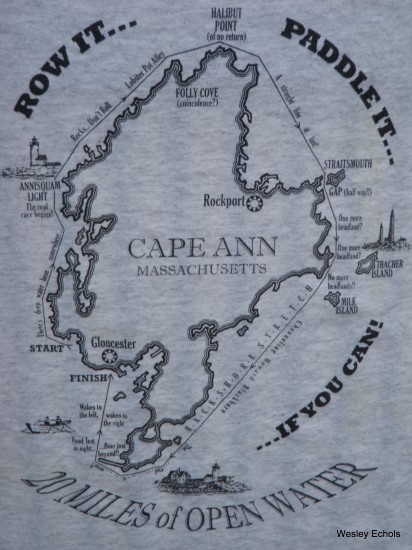
Blackburn Shirt with course Designed by Dana Gaines(27 X finisher of Blackburn) and graphic artist.
Like any distance race, training is a combination of long paddles, tempo paddles, intervals and time in the bucket, and picking the right ski for your skill level so you don’t get “boat fatigue” with is different from “physical fatigue” of paddling 19.5 miles at 85% of your max. The Blackburn Course has a great combination of different types of waters since you go around Cape Ann: 3 miles of flat water on the Annisquam, the kind of water, flat water paddlers love and the over excited paddlers, then you have a few miles of “typical ocean waters” in Sandy Bay where you can find your groove, then at Land’s End, the water takes on a different feel until you pass Good Harbor. That section was just a warm up for the uninformed of what is to come; the few miles just before Brace Cove and afterwards before you finally set eyes on the Eastern Point Lighthouse built in 1832 to protect fisherman and sailors while entering Gloucester Harbor. Gloucester is America’s, oldest seaport. The deep ocean water here is alway moving asymmetrically even on a flat day as it was for this race. Due to deep water over 1oo ft deep, ledges, swells, wind, tide, and boat traffic can make this section and the next mile around Eastern Point extremely difficult. At this point in the race, you are at the 2 hour and 30 minute mark, battling physical fatigue, boat fatigue, cramping, dehydration, and you are practically counting your strokes and until you reach the Dog Bar. See Leslie’s great photos below.
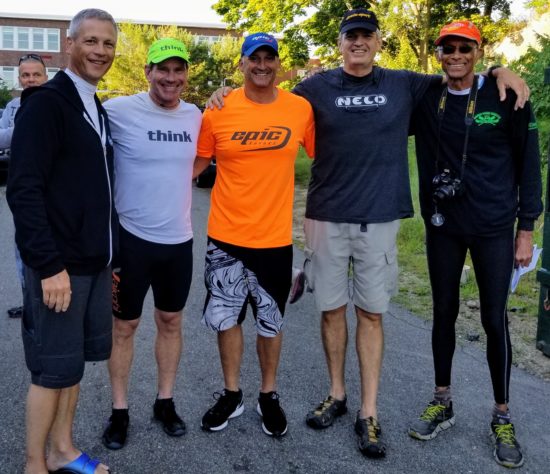
Steve, Wesley, Eric C, Chris, Roger

https://chappellstudio.smugmug.com/Folder-Here/Blackburn-2018/
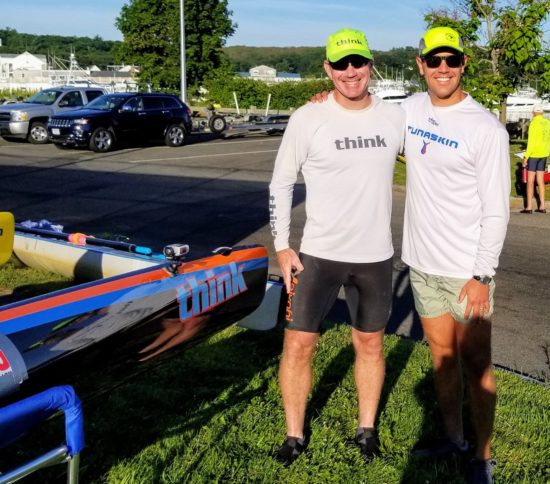
Wesley and Chris Quinn the Rhode Island contingent this year. It was Chris’s 1st BB and placed 6th. Well Done!
History of Dog Bar Copied from the below link.
The 2,250-foot-long breakwater in front of the Eastern Point Lighthouse was built using 231,756 tons of Cape Ann granite blocks for $300,000 between 1894 and 1905 to protect the harbor. Before the breakwater was completed, nearly forty ships had crashed into it, demonstrating the need for a light to mark the outward end of the obstacle. A wooden tripod supporting a beacon was installed, and the keepers at Eastern Point Light were given the added responsibility of caring for the light, known as Gloucester Breakwater Light or Dog Bar Breakwater Light, as the breakwater was built over dangerous Dog Bar Reef. This additional duty could become quite dangerous when gale-swept waves broke over the breakwater and ice coated the granite blocks.
Even after Eastern Point Lighthouse was lit in 1832, ships continued to run aground on dangerous Dog Bar Reef, which extends shoreward from the point. Thus, the decision was made to build a breakwater over the ledge, which in addition to covering the reef provided sheltered waters in the harbor.The Army Corps of Engineers built the 2,250-foot breakwater stretching out from Eastern Point Light between 1894 and 1905, as Congress doled out the requisite funds.The substructure of the breakwater is a rubble mound covered with 231,756 tons of Cape Ann granite blocks, each one weighing 12-13 tons. The breakwater was constructed for $300,000 and is 7½ feet above mean high water and ten feet wide.
Eastern Point Lighthouse History
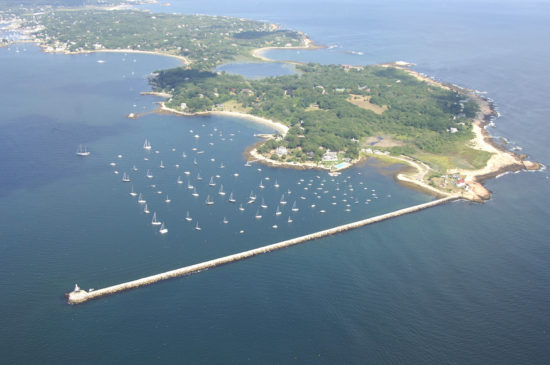
Dog Bar
Once you reach the Dog Bar, your rough water paddling skills or lack thereof is exposed. The skilled will take the shortest line as many of us did today since it was benign for this race. On an average to big day, the water is so chaotic due to refractory waves, massive boat traffic, deep waters, swell action on top of wind driven waves, even the best paddlers give pause. Then you make the turn around the Dog Bar into the Harbor where the unknowing may think, “at last calm water” or as Bob Dylan said “harbor from the storm”. Typically this 2 mile sprint to the finish, has more boat traffic and today’s race the harbor was choppy in a different fashion from the previous years.
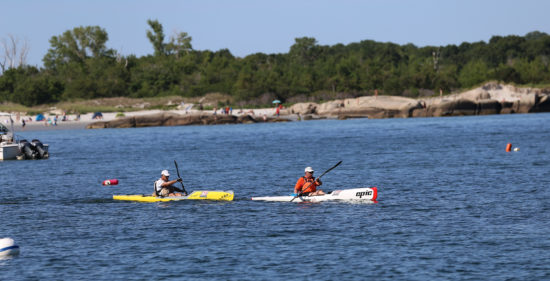
Bill K leading Dana.
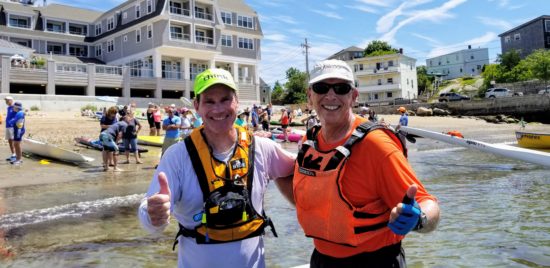
Wesley and Bill K(one gear Bill) but its strong gear that keeps on grinding! Giving it the old school(not cool) thumbs up!
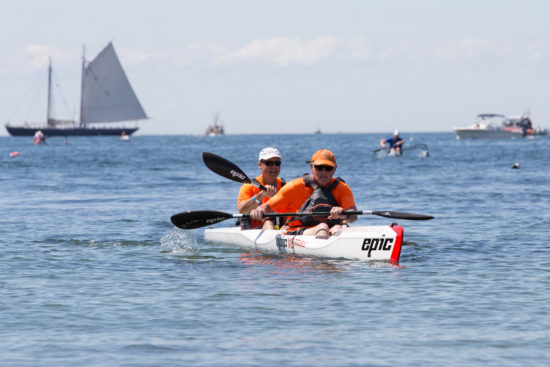
Ed Duggan(1st paddler to own surfski in New England) still getting the job done with Bruce(the Torch) in a double. Great Job guys!
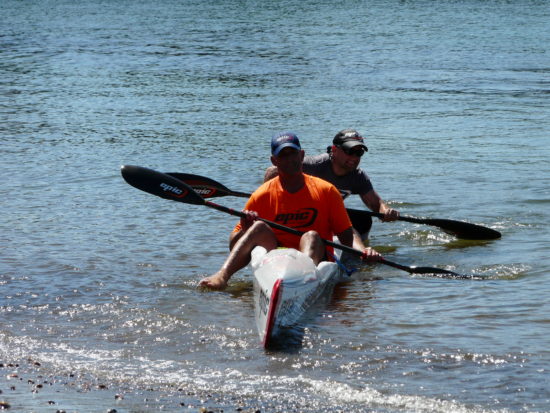
Eric C and Bruce P take 1st in doubles and missed the course record by seconds!
While part of your self talk is telling you “just paddle, try to endure the next 2 miles and finish, the competitive side of you is telling you to drop the hammer if you want to have a “Good Blackburn”, because their is always some other surfski racer just like you, tracking you, hunting you down, pushing the pace with every stroke and every beat of his/her heart. For this reason, despite my many years of racing, I added my 2018 Blackburn mantra to my Think Evo Ultimate to get me through the tough sections of the race: Push, meaning push the pace, do not let your pace and heart rate drop. Some of you may think this is amusing, but looking back over my 16 years of racing this race, I always slow down from miles 14 to 17.5 which are the toughest for me. Most often I am up for the challenge of the 2 mile sprint from the Dog Bar to the finish that requires focus, increased effort, and some something in reserve for the final push.
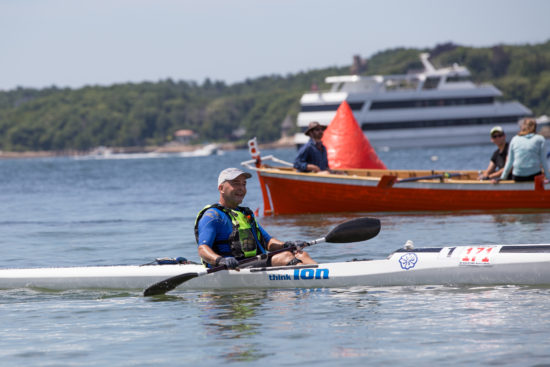
Richard Germain finishes yet another Blackburn to go along with his 5x Molokai Finishes! Richard know a thing or two about getting it done!
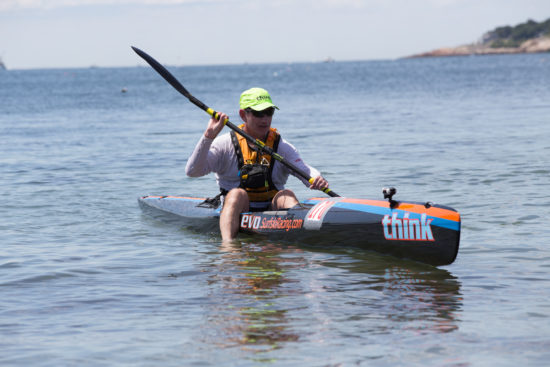
A “Good Blackburn”, 12th, 2:57: 32, My 16th consecutive.
The Race
The overall numbers seem to be down for this year’s race. Certainly the HPK class (surfski) class and SS20 class were in part due to the Downwind Championships in Hood River, Oregon, the largest field of surfskis every assembled in US history, 650! Many locals New Englanders, and Eastern Coast paddlers chose to do the “Gorge” as it is called. Nevertheless, we had 28 surfskis in a very competitive field with 1x winner Eric Mims of South Carolina, 2X winner Craig Impens of NJ, Flavio Costa from FL along with several newcomers including 4th place finisher Robert Jehn, Chris Quinn(6th), and Kurt Hadem(7th).
Blackburn Results
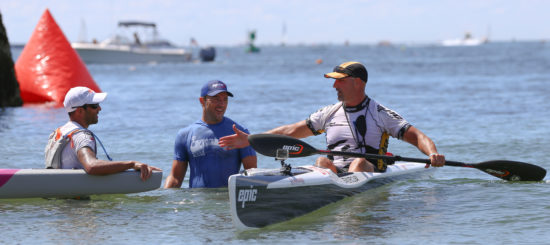
Flavio, Eric, Craig
Eric Mims chalked up his second win of the Blackburn and he is getting faster every time he does it, coming in at a very fast 2:37:29. Breaking 2:40:00 at the Blackburn puts you in the top echelon of Blackburn racers. So congratulations to Eric, Flavio, and Craig for their top place finishes on a moderate to fast flat course for this year’s race. There were no women racers in the HPK class this year. Where are all the women racers? Even at the Gorge with the huge field of international paddlers, I thought there would have been more women. So Women paddlers WANTED!
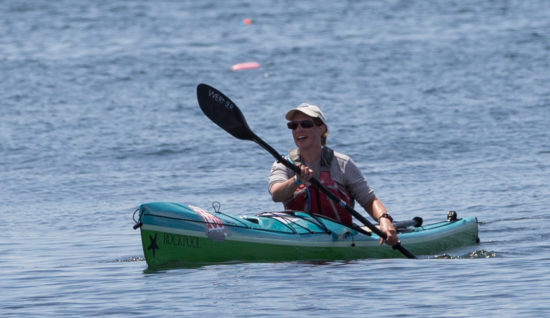
Mellisa wins the FSK SINGLE WOMEN with time of 3:36:35. No women in the HPK Women’s this year. Hopefully Mellisa will be joining the surfski world in the near future! So stay tuned! I am encouraging to do so. She has an amazing skill set from her sea kayaking training, adventures, and certifications.
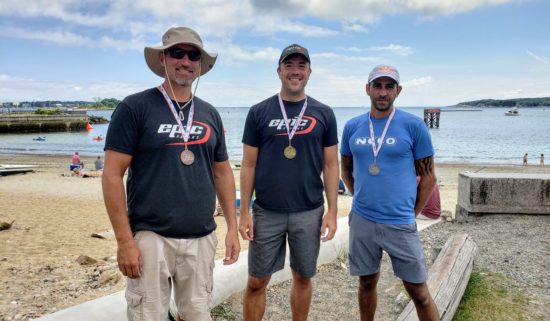
Craig(3rd), Eric(winner), Flavio(2nd)
There are many races within a big race and I can’t write about all of them so I will just give a shout out to a few I remember in making the rounds after the race: Ed Duggan/Bruce Deltorchio for breaking the 3 hour mark in a double; also winner of the class Eric Costanzo and Bruce Poacher clocked sub 2:30:00 and missed the Blackburn doubles record by a few seconds; ageless Roger Gocking/Royal got under 3 hours in their double despite a going a few tenths extra in the harbor; 1st timer and Rhode Island native, smooth stroking Chris Quinn got a well deserved 6th and will only get faster with youth, and training; Kurt Hadem(7th) is putting in the time on the water after many years of sea kayaking; John Hair had a “Good Blackburn” but we know John is capable of even a better times; Richard Germain has done many Blackburns and has been very consistent over all his Blackburns and his 5x finishes of Molokai Challenge; Dana Gains(Mr. Blackburn with 27) posted an excellent time despite shoulder surgery only a few months ago; ever smiling, one gear Bill K was slightly ahead Dana in the SS20 class; triathlete Janda Ricci-Munn paddle a V7(55lbs) within seconds of breaking 3 hrs after pulling winner Justin Schaay(V8 GT,) around to course to out sprint Janda at the end, so more to come from Janda after he moves up to an intermediate ski; Ben Randall was determined to have a “Good Blackburn” so upgraded his ski, changed his training regiment and got the results he deserved; Kirk Olsen paddled another Blackburn with a consistent time despite some injuries; Francisco crammed a massive amount of training in a few weeks and broke the 3 hour mark again;Hank Thorburn finished his 1st Blackburn in a respectable time too, Jay Appleton finishes his 18 consecutive Blackburn, and lastly Chris finished his 5th Blackburn after winning the SS20 class last year and allowing me to draft off him for a few miles early on in the race which I am grateful!
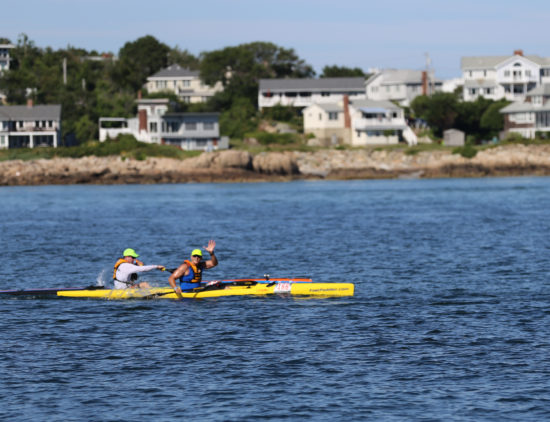
Chris waving to Leslie taking these great pics while I am trying to hang on his wash!
My Race
My strategy this year was to paddle often the same ski I would be racing the Blackburn, my Think Evo 3g Ultimate. I am sure I hold the record for paddling a different ski in virtually every Blackburn. I was determined to keep the pace up from mile 14 to 17.5 and not lose time. While I have done many Blackburns in advanced skis with excellent times(2:48:30 my best in 2011), as I have gotten older, particular for this race, I don’t want any boat fatigue, I just want to paddle hard. So I got off to very good start in the middle of the Annisquam averaging 7.8 mph with no drafting. I wanted to ride someone’s but wash but did not get that opportunity until just before we exited the river with training partner Chris Chappell catching up to me. I hopped own and rode Chris’s wash for 3 miles or so. We dropped the guys who were riding my wash, and put the guy in the Fenn ski in our sights. We caught him and he rode our wash for about 2 miles, pausing when we did to have gel and a sip of water. Before Chris joined me I was in my flat water malaise mode. I don’t like paddling intermediate skis on flat water. While I was going well enough, keeping up with Chris in flatter conditions is tough but that provided the extra zip I needed. So together we had a very good 3 to 4 miles of paddling, just as we have done for years on the Sakonnet, my home training grounds, and Chris’s home away from the Sudbury River.
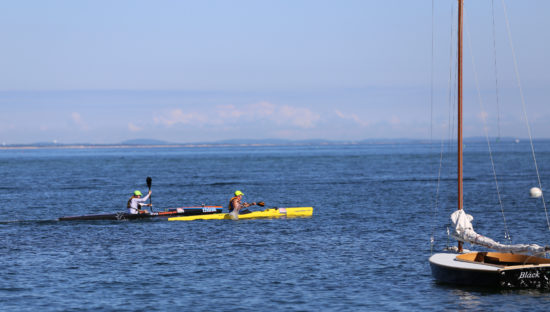
Wesley drafting Chris
As we approached Sandy Bay, I slowed a few times to gauge how Chris was feeling in the smooth lumpy water. Chris slowed some and I pushed on catching a few bumps to the half way point. I passed a SUP paddler with his music blaring from his phone via his wireless speakers, not my kind of music! At mile 12, I begin to count my miles to the Dog Bar. Fortunately, the went by relatively fast this year. I only cramped for about ten seconds, and that was relieved by a very long pull from hydro pack. I focused on my heart rate and not falling into the sometimes trap of paddling at my training pace with the goal of breaking three hours which is the second goal of many surfski paddlers after they have completed one Blackburn. After you have broken three hours, the next goal is 2:50:00 with I have only done once or twice. Typically I am in the 2:52 to 2:58 range if I am trained up and ready to go and have a “Good Blackburn”. So the rest of my race was unremarkable, no one to chase. I thought mistakenly there was a gap between me and the next place paddler since you lose sight of paddlers taking different lines, etc. However Michael Dauost was tracking me the whole race. Once I rounded the Dog Bar, I looked at my GPS 920XT Garmin and did some slow math(math is not my strength) and calculated, I may not break three hours with the tide going out and the small chopped up conditions of the harbor. So I pushed the pace for the next mile, did another calculation and I realize I was in fact going to break three hours with 2 minutes and 30 seconds to spare. Yahoo!! I also held off Michael (30 seconds behind)who was closing on me he said after the race until the 2 mile sprint to the finish. My other goal was to be in the top 10 but due to the high caliber paddlers in the field I placed 12th, not bad for the oldest in the field. I will take it with another “Good Blackburn”.
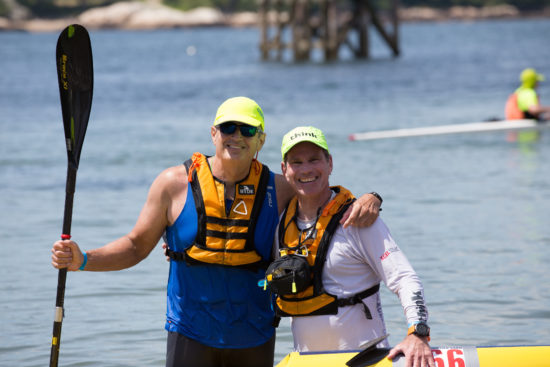
Chris(FastPaddler.com) and Wesley(SurfskiRacing.com after another “Good Blackburn”
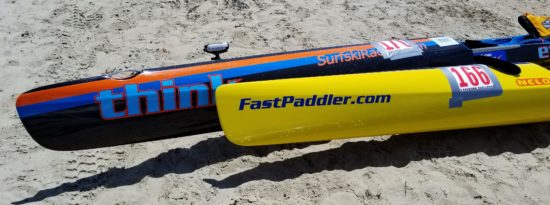
So thanks go out to Bob Blair, Race Director, Donna Lind, Susanne, and many more volunteers I don’t know who make the Blackburn happen. It takes a lot of work and these guys have day jobs just like the rest of us and spend many hours of planning and executing to pull off another successful Blackburn Challenge. So if you did not thank them, you will have your chance at next years Blackburn. Also big thanks to Leslie Chappell for taking professional photos of many paddlers. It takes hours taking the photos, another one to upload the photos, another 2 hours sorting, cropping, etc before you see the final gallery.

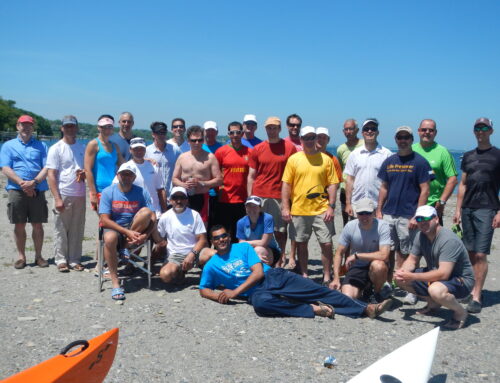
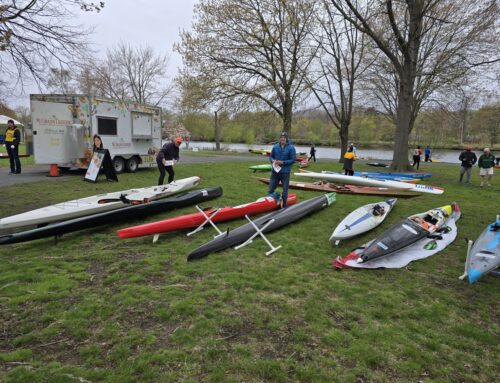
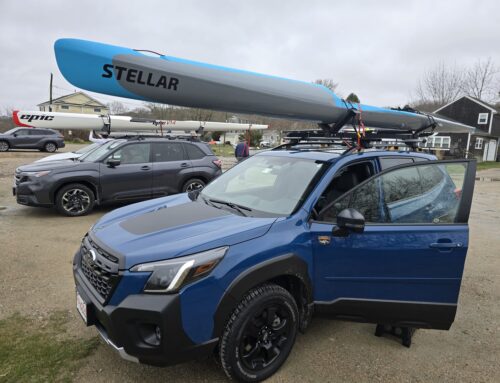
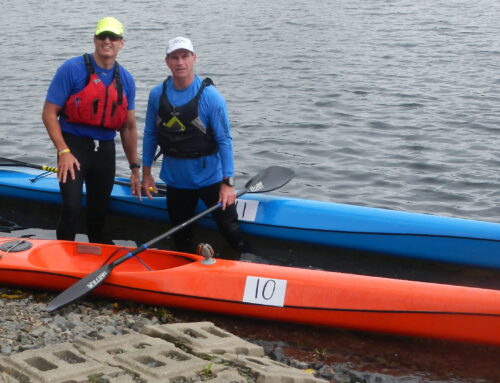
Leave A Comment
You must be logged in to post a comment.